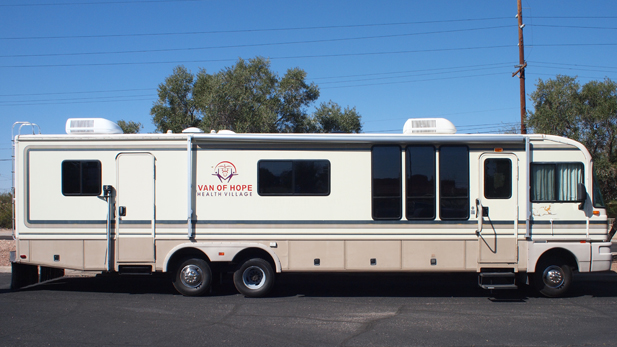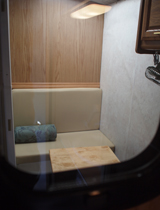 Van of Hope brings health care to the "most vulnerable of the most vulnerable," says care coordinator David Oroz.
Van of Hope brings health care to the "most vulnerable of the most vulnerable," says care coordinator David Oroz.On any given night in Tucson, nearly 8,000 people have nowhere to go.
Less than half of Tucson’s homeless population goes to local shelters when evening settles on the city. Fewer still seek out hospitals or clinics, even though they’re three to six times more likely to become ill than housed people.
There are many reasons why, says Kathy Hall, manager of the Carondelet Health Network’s Southern Arizona Health Village for the Homeless program.
Lack of transportation and insurance, distrust of authority, and embarrassment or self-consciousness about being homeless can all play a role, Hall says. But the result is the same.
“It’s hard to reach out to the homeless,” Hall says. “Sometimes they just won’t come in to get the help they need.”
That’s why one local program is taking the help to the homeless. Van of Hope, a 38-foot converted RV, hits the streets of Tucson each day, bringing medical care to churches, shelters and other places where the city’s homeless gather.
The mobile clinic offers its clients checkups, counseling, referrals, and the odds and ends that are so precious on the streets: chapstick, toothbrushes, soap and shampoo.
 Van of Hope features a small behavioral health "booth" where clients can have private therapy sessions with on-board therapist Robert Boyer.
Van of Hope features a small behavioral health "booth" where clients can have private therapy sessions with on-board therapist Robert Boyer.“Helping the homeless with dignity is part of the goal here,” says Robert Boyer, Van of Hope’s on-board behavioral health therapist.
Boyer is part of a close-knit crew that also includes two nurse practitioners, a medical assistant, a care coordinator and a driver. Most have been with the project since its inception in 2010, when an anonymous donor gave Carondelet $2 million to help the local community.
The help Van of Hope provides is invaluable, says John Lozier, executive director of the National Health Care for the Homeless Council.
“We’re talking about a population that is profoundly ill, and profoundly disaffiliated from the health care system,” he says.
“After all, you may not tend to your health care needs if rather than waiting in line at a clinic, you need to wait in line for food or shelter,” Lozier says. “That makes mobile clinics a critically important part of the system in terms of actually reaching people and bringing them into services.”
But though they may be critical, mobile clinics are also limited. Many don’t provide dental care or physical therapy, two services that clients need and often ask for on the Van of Hope.
“Every day, I can meet people’s needs … tell them where they can get shelter, food, other services we can’t provide,” says David Oroz, Van of Hope’s care coordinator and a medical resident with the University of Arizona College of Medicine. “That’s always satisfying. Being limited is the hard thing.”
But for people living on the edge, even limited care can be life-changing.
Kat Bailot was struggling with multiple health problems and clinical depression when she found her way to Van of Hope. She and her husband, Issa, have been unable to afford housing or adequate care since Issa was injured in a hit-and-run automobile accident a year ago.
“For the first time, I felt like someone really wanted to help me,” she says. “They really care. David really cares.”
Bailot, who lives in a Saturn station wagon with Issa and their two dogs, was able to get treatment and medication through Van of Hope. She credits them with saving her life.
“Finding good care is life and death when you’re homeless,” she says. “It gives you a little hope.”
Lozier says more mobile clinic programs that work closely with local partners to supplement their services—as Van of Hope does with Carondelet, El Rio Community Health Center and a host of other community groups—would better serve the needs of people like the Bailots.
But the greatest help to the homeless, says Lozier, would come from health care reform that offers care to uninsured. Nationally, about 65 percent of the homeless have no insurance coverage.
“It’s a public health issue, as well as a matter of moral obligation, to provide basic care for everyone among us,” says Lozier. “Wouldn’t we all be better off if everyone were eligible for health care, simply by virtue of drawing breath?”

By submitting your comments, you hereby give AZPM the right to post your comments and potentially use them in any other form of media operated by this institution.